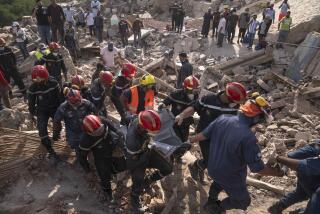Take a Pass on Trip Through Atlas Mountains
- Share via
MARRAKECH, Morocco — Dawn broke over the red city of Marrakech as my traveling companion, Phyllis, and I left Marrakech to travel south across the High Atlas Mountains to Ouarzazate, then northeast along the route of the casbahs to Khenifra, Meknes and Fes.
Sunburned houses flat as Moroccan bread, burdened donkeys, sheep nibbling the winter-green grass and the domed shrines of Berber saints loomed ahead.
We rented a car and hired a driver; the total cost came to half the price of a tour bus. At our leisure, we could stop to buy folk art in the villages and take pictures of casbah ruins. Also, we would investigate the beginning of the Sahara Desert and experience sunrise at Zagora.
Soon we were in and out of the foothills, beginning our three-day trip. The landscape was much like California’s High Sierra with rocky escarpments and pine forest. In front of us were white peaks stuck up above a tree-lined horizon.
We were on the route of Tizi-N’Tichka (“difficult”) Pass, a road that rated two stars in Michelin and appeared well named as we corkscrewed up the mountain.
At 9,000-feet, the summit did not compare with the 14,000-foot peak of Jebel Toubkal nor even 11,000-foot Mt. Bouiblan, but we could see why skiing is considered a growth industry here.
We followed surly rivers and were hit by snow flurries so dense that they whitened out all but the truck inching along ahead of us. We plowed past hamlets with names we would be unable to find later on any maps, but which all began with T. They were called by the locals: “big village . . . small village . . . new village.”
Our forward motion ended abruptly after we had taken the mountain and were only 30 miles from Ouarzazate. The now red and angry river had crossed the road. A bus could lumber over like an oversized hippo, but our car could not.
By morning, snow had closed Tizi N’Tichka Pass, and we thought about taking the coast road to Agadir where we might skirt the 300-mile mountain range and reach the desert.
“Water flows to Atlantic,” our driver said, meaning this way was flooded. We took it as a sign that we should forget the desert and spend an extra night in Fes. We headed east.
First we paid nearly $30 for gas, high for filling the tank of such a small car in a country where gas was supposedly cheap. Later we would wonder about a station without visible prices (most stations were similar to their U.S. counterparts), and where our driver and the attendant were old friends.
But for now, the High Atlas was on our right, the Middle Atlas on our left and we were quickly distracted by camels coaxed along by young herders and by snappily costumed horsemen on their way to perform in village “fantasies,” those gallop-and-shoot spectaculars that are part of every Moroccan festival.
Desert nomads had come, too, pitching their black, goat-hair tents in clusters around town commons and along the river fronts. If we could not go to the Sahara, perhaps the Sahara was coming to us.
We crossed the Haduz Plain where apples, olives, lemons, oranges and apricots are grown. The two-lane road was straight and bordered by eucalyptus trees.
Our driver drove with one hand on the wheel, without regard for center lines. Oncoming trucks flashed their lights menacingly.
Hedges of prickly-pear cactus (called “Christian fig” by the Moors) formed living fences around plots of land and mud houses. Here in the countryside people wore traditional clothes, were friendly and waved to us as we passed.
We stopped for lunch in Khenifra and drove into the foothills of the Middle Atlas, past high green meadows dabbed with wild orange marigolds and blue-flowered borage. Traffic was minimal: A few trucks and white donkeys laden with twigs were honked out of the way by white-robed Arabs speeding toward Marrakech in their Mercedes 600s.
Barbary apes once swung through these trees in large numbers. It is said that there are still descendants living in the cork forests near Meknes. Elephants were native too, thriving in the northern foothills where some were captured by Hannibal and taken to Spain.
Arriving at the crenelated walls of Fes at dusk, we managed happily to get into the elegant Hotel Palais Jamai without reservations.
On the last day, when our driver went home to Marrakech, Phyllis contracted through the hotel concierge for a taxi to Casablanca, where we caught our plane home. She paid the driver a tad more to go via the historic old city of Moulay-Idriss and the Roman ruins of Volubilis.
International road signs, light traffic and well-maintained roads make self-driven cars a good way to see Morocco. It helps to have some knowledge of French or at least a phrase book. Buy a road map such as Michelin, examine the tires (including the spare) and check the oil and water before you start.
Carry an international driver’s license (available at AAA offices in the United States). Even when dealing with a U.S.-based rental agency, read the contract’s small print.
If you decide to hire a car and driver, get a package agreement. Better yet, get a driver with his own car. Negotiate and agree on prices in advance.
Get everything in writing (be sure your driver understands it and have him sign the paper). Don’t be intimidated. Although hotel concierges use regular drivers who have proved trustworthy, have the concierge also read and sign the contract. If you think the rate is too high, say so. It will probably come down.
If you are traveling November through April or crossing the High Atlas, get an advance report on weather conditions.
Morocco has strict rules governing guides. Although your driver/guide may be quite competent to take you through a monument, he cannot do so. You must hire a local guide or go it alone.
The best guides are officially licensed, wear a badge and you get them through your hotel. The rate is about $6 for half a day.
Reserve a car through your travel agent for best price and availability. In Morocco, expect to pay $40 to $60 (depending on season and length of rental) per day for a small to medium stick-shift model, with unlimited mileage, plus gas and 19% tax. A driver will be $25 to $50 more per day.
For more information on travel to Morocco, contact the Moroccan National Tourist Office, 20 East 46th St., Suite 1201, New York 10017, (212) 557-2520.
More to Read
Sign up for The Wild
We’ll help you find the best places to hike, bike and run, as well as the perfect silent spots for meditation and yoga.
You may occasionally receive promotional content from the Los Angeles Times.






